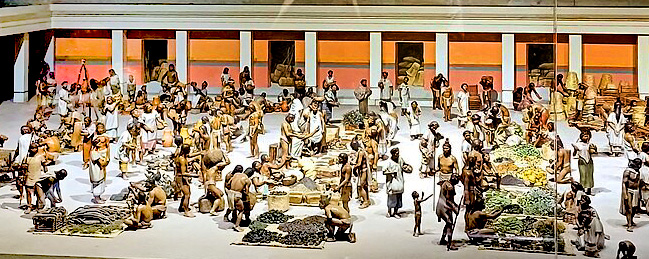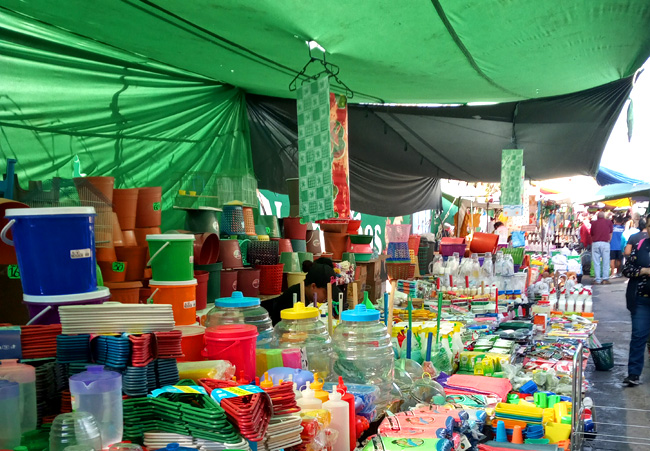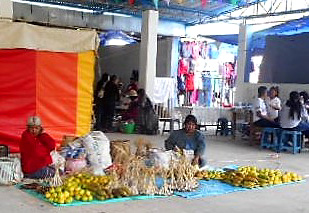
Detail of panoramic display of Tlatelolco tianguis in ancient Aztec times, on display in the National Museum of Anthropology in Mexico City in 2024; copyright free image courtesy of José Luiz Bernardes Ribeiro made available through Wikimedia Commons.
In 1519, the foot soldier Bernal Díaz del Castillo accompanying conquistador Hernán Cortés saw approximately what's depicted above. In his book Historia verdadera de la conquista de la Nueva España, he listed as being sold every conceivable kind of food, from many kinds of corn, beans, squash and chili to chia, cocoa, turkeys, quail, pigeons, ducks, dogs, snakes, ants, grasshoppers, fish, crustaceans, honey, and much more. Also there were fine pieces of gold, silver and copper, cotton blankets, pottery, mats, baskets, knives, mortars, animals skins, bones, sponges, shells, firewood, coal, stone, pigments and lime. There were all kinds of medicinal herbs and roots, and places to drink atole of cacao and corn (maize), eat fish roasted or cooked, tortillas, and tamales of all kinds. You could have your head washed and shaved, and buy slaves. The tianguis was policed, and there were judges to deal with commercial conflicts, and the means to punish criminal acts taking place in the tianguis vicinity.
The term tianguis derives from a word in the classical Nahuatl language used by the Aztecs, the word tiyānquiztli, which just means "marketplace." Today, what's called a tianguis may look like what's seen below:

Tianguis de Jesús María in Aguascalientes, in 2025; copyright free image courtesy of "Salazar Lira Hanna Elizabeth" made available through Wikimedia Commons.

Selling garlic and fruits in San Juan Achiutla, Oaxaca, in 2019; copyright free image courtesy of Eduardo Ruiz Mondragón made available through Wikimedia Commons.
In short, the concept of what a tianguis is has changed, as the times have changed. Today some insist that in an "authentic" tianguis one expects more of a traditional, indigenous flavor -- handmade pottery and textiles, local indigenous medicinal herbs, foods and drinks, and indigenous people selling their products, as seen at the right. Others say that any open-air flea market is a tianguis.
Whatever you call a tianguis, it's worth remembering that the tianguis always has been an important feature of Mexican history. In 1976, Martin Diskin and Scott Cook published a now-classic study of mercados of Oaxaca state, Markets of Oaxaca. That book considered the origins of goods sold in the weekly tianguis of the town of Nochixtlán, about sixty-five miles northwest of Oaxaca City, on Highway 190. They found that many articles came from cottage industries in nearby villages. Cheeses were made in the villages of Etlatongo, Tinú, and Nochixtlán itself; candles were a specialty of the town of Yodocono; Zahuatlán specialized in fresh flowers, and; several artisans in Tilantongo and Tidaá carved wooden spoons.
Many towns, even those hosting daily mercados, may designate one day of the week as tianguis day. The mercado in Toluca, México state, always is busy, but on Friday's tianguis day, at the Tianguis de Palmillas, business really takes off, with sidewalks and streets in the area becoming jammed.
Sometimes a town's weekly tianguis day is coordinated with weekly markets in nearby populations. For example, in the southern state of Oaxaca, at least three distinct cycles of coordinated weekly markets were noted by Diskin and Cook. One cycle took place around Oaxaca City, another in the Nochixtlán area, and the third among towns in the Isthmus of Tehuantepec. Here is (was?) the cycle for the Oaxaca City area:
Tuesday.....Ayoquezco
Wednesday...Etla & Zimatlán
Thursday....Ejutla & Zaachila
Friday......Ocotlán
Saturday....Oaxaca
Sunday......Tlacolula